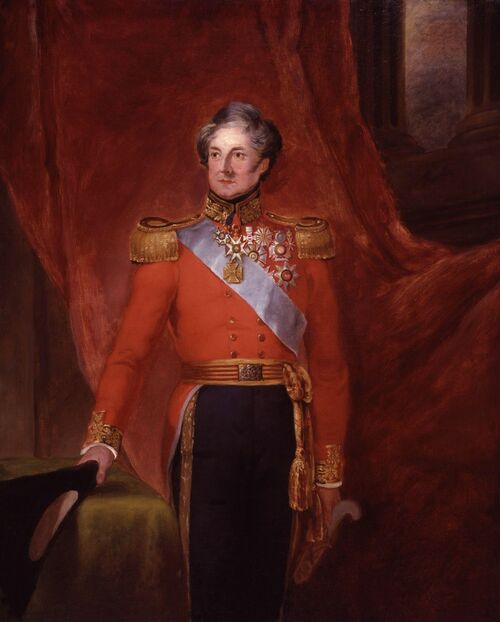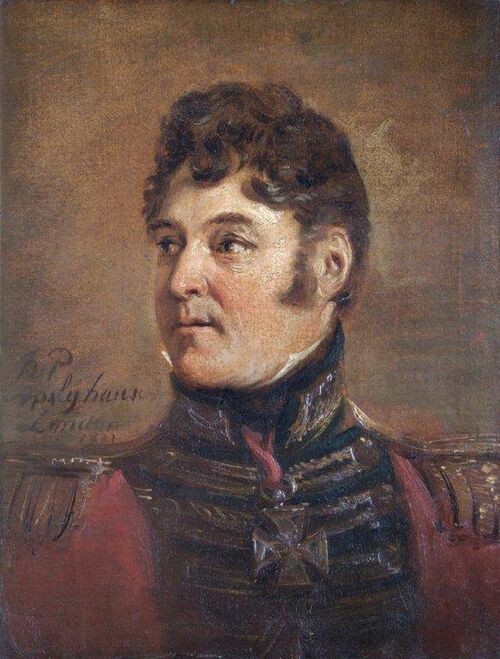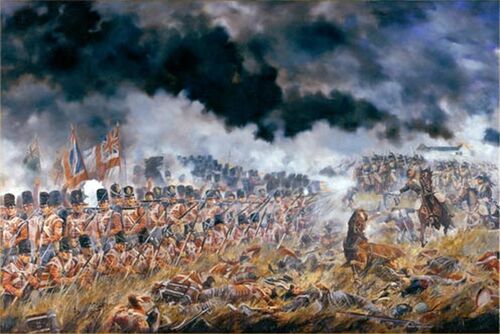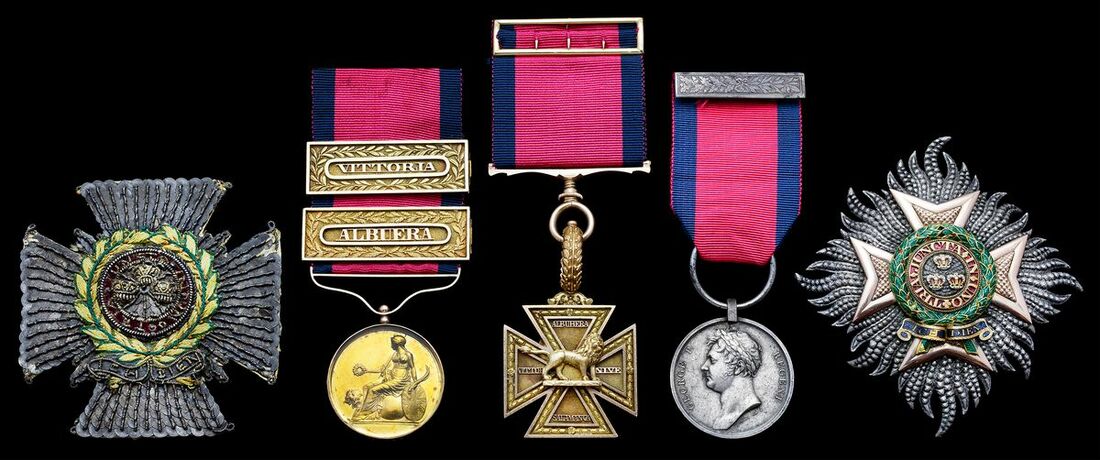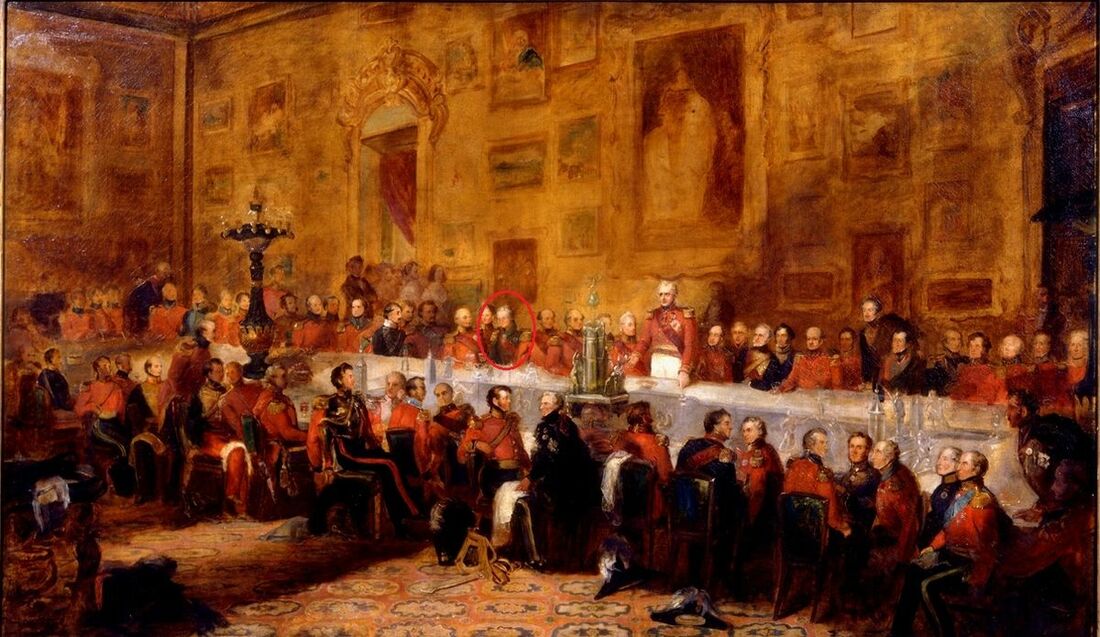Auction: 24002 - Orders, Decorations and Medals
Lot: 189
(x) "My Lord, we are dreadfully cut up; can you not relieve us for a little while?"
"Impossible!"
"Very well My Lord: we'll stand until the last man falls..."
Halkett and the Duke of Wellington share a few words at the height of crisis-point, 18 June 1815
The exceptional and historically important G.C.B., Army Gold Cross, Army Small Gold Medal group of five awarded to General Sir C. Halkett, the man partially responsible for founding the famous King's German Legion and who commanded the Light Brigade of that Corps throughout the Peninsular War; in command of a Brigade at Waterloo, his men were in the thick of the fighting throughout and suffered some of the heaviest casualties of the Hundred Days campaign - Halkett, indeed, was wounded no less than four times on the field of Waterloo but survived to become Commander-in-Chief of the Bombay Army and Governor of the Royal Hospital Chelsea
The Most Honourable Order of the Bath, G.C.B. breast Star, gold, silver, and enamels, the reverse engraved 'Gilbert, Jeweller, to their Majesties, Cock Spur Street', 86mm x 92mm; The Most Honourable Order of the Bath, K.C.B. breast Star, cloth and silver bullion 'wearing Star', backed on old waxed paper with a hand-written inscription in ink 'Sir Colin Halkett - Order of the German Legion', 72mm x 80mm; Army Gold Cross 1806-14, gold, for Albuhera, Nive, Salamanca, Vittoria (Colonel Colin Halkett), mounted upon a gold three-pronged buckle; Field Officer's Small Gold Medal 1808-14, for Salamanca, 2 clasps, Albuera, Vittoria (Coll. Colin Halkett); Waterloo 1815, with original steel clip and ring suspension (Col. Sir Colin Halkett, 2nd Light Batt. K.G.L.), with ornate silver riband bar, first with one or two slightly bent arms, lacking reverse pin, small chips of enamel loss around wreath and motto; second missing a few spangles around corners of arms, fourth with lunettes replaced, otherwise good very fine, an important collection of the greatest rarity (5)
Provenance:
Sotheby, Wilkinson & Hodge, 29 June 1904, 'The Property of a Gentleman whose Collection is Famous.'
Whitaker Collection.
Hayward Collection.
Note: a second Waterloo Medal to Halkett is known, named: 'Major-General Sir Colin Halkett, K.C.B.' Both are entirely correct, so this is a clear case of one Medal being issued off the Staff roll and another off the Regimental roll - indeed, this can be confirmed as the Waterloo Medal Roll specifically notes Halkett's name and Regimental rank on the list of medals for members of the 2nd Light Battalion King's German Legion, and again (with his Army rank) under the heading 'General and Staff Officers'.
Colin Halkett was born at Venlo, Netherlands on 7 September 1774, son of Major-General Frederick Godar Halkett, an officer in the 'Scots Brigade' - a most unusual formation technically loaned by the British Government to their Dutch allies with a history dating as far back as 1586. The officers were, for the most part, of Scottish descent and the Halkett's were no exception; Colin's ancestors had a tradition of military service in both Scottish and Anglo-Dutch regiments going back several generations. In March 1792, young Halkett followed in the family footsteps with a commission as Ensign in the 2nd Battalion Dutch Foot Guards. Within a few years he had been promoted Captain in the 1st Battalion of the same regiment, but retired (at his own request) in April 1795.
In January 1799 he was commissioned into the British Army proper, as Ensign in the 3rd (The Buffs) Regiment of Foot who, interestingly, could also trace their lineage back to Dutch service - perhaps at least in part the reason for his joining. However, he never actually served with the unit as by February 1800 he transferred (as Captain) to the 2nd Dutch Light Infantry, a regiment within the 'Dutch Levies' taken on to British pay and quartered on Guernsey, with further detachments on the Isle of Wight and the Channel Islands until 1803 when the Peace of Amiens brought about their disbandment. Though Halkett was discharged from military service he did not have long to wait before re-employment.
From Dutch to Hanoverian Service
In August 1803, the Hanoverian Army was disbanded under the provisions of the Treaty of Lauenburg; Halkett, noted as a 'Major in Dutch Service', was authorised by the British Government to recruit some of these recently-redundant troops and raise a battalion of Light Infantry of no less than 489 men. He was to hold the rank of Major-Commandant, but with the proviso that should the unit reach 800-strong he would be promoted Lieutenant-Colonel. This, then, can be seen as the nucleus of the soon-to-be famous King's German Legion who served with such distinction throughout the Napoleonic Wars up until - and including - the bloody Battle of Waterloo. Along with the similar efforts of a fellow officer, Lieutenant-Colonel Baron von der Decken, these two units were officially titled the 1st and 2nd Light Battalions K.G.L.; dressed in the new green uniforms of riflemen and armed with the Baker Rifle, they were the elite of the Corps and based at Bexhill, Sussex. Halkett officially received his Lieutenant-Colonelcy on 17 November 1803.
The concept of whole battalions of Light Infantry was a relatively new one in the British Army, but it was a very successful enterprise and the men were trained well by inspirational and intelligent officers - Halkett of course one of their number. After three years of training, he and the men of the 2nd Light Battalion were ordered back to Hanover as part of Lord Cathcart's Weser Expedition, an attempt by the Third Coalition to bring a land war to France. Unfortunately, after occupying Hanover in December and engaging in a few skirmishes, a Franco-Prussian treaty in January 1806 led to a swift withdrawal back to Britain and a period of far less exciting garrison duty in Ireland. Surviving a shipwreck off Land's End on 30 May 1807, his battalion then formed part of the K.G.L. Division for the Copenhagen Expedition of August-September 1807, in which a young Major-General Sir Arthur Wellesley also participated. The swift conclusion of the expedition next led to an abortive assignment to Sweden, before deployment to Portugal and Spain with the army under the command of the famous exponent of Light Infantry troops, Lieutenant-General Sir John Moore.
Command in the Peninsula
Though part of the British Army for the Corunna campaign, after the promising advance to Salamanca so began the dreadful winter retreat back to the northern coast; whilst the Battle of Corunna (16 January 1809) is often seen as a 'Napoleonic Dunkirk', Halkett and his men missed the action entirely as both Robert Craufurd's and Charles Alten's Light Brigades were instead ordered to the port of Vigo, from whence they sailed for home. After the setbacks of Hanover and Sweden, another despondent conclusion to a campaign must have been a great disappointment to all concerned. Worse was still to come, however, as the 2nd Battalion was soon after selected for service in the Light Division in the disappointing and anticlimactic Walcheren Campaign of 1809, where far more men died of illness and disease than ever exchanged fire with the French; they were back in Britain by the closing days of that year.
After spending time recruiting, recovering and retraining, Halkett was ordered back to the Iberian Peninsula and, again at the head of his riflemen, joined William Beresford's army in April 1811 as they lay siege to the fortress of Badajoz. Forced to abandon their efforts due to the advance of Marshal Soult and his Army of Andalusia, Beresford took up defensive positions on the heights overlooking the village of Albuera and, on 16 May, Soult attacked. Both 1st and 2nd Light Battalions K.G.L. were responsible for the defence of Albuera itself, on the left-centre of the Allied position. Believed to be a focus of French attention, Halkett and the K.G.L. actually saw very little hard fighting as Soult only made a feint attack against the village with the bulk of his forces falling on the Allied right flank - here, extremely serious fighting developed and, indeed, the battle nearly resulted in a French victory. Nevertheless Beresford's forces carried the day, and Halkett had fought in his first true 'general engagement' of his military career.
Promoted brevet Colonel on 1 January 1812, Halkett was now placed in command of a larger formation - specifically the 1st Brigade of the Seventh Division, comprising both Light Battalions of the K.G.L. and seven companies of Brunswick Light Infantry; it was in this capacity that he fought at the Battle of Salamanca, though the entire Division spent much of the battle in support of the Fifth Division which, at times, was hard-pressed and took severe casualties - nevertheless, this earned Halkett his Small Gold Medal, with of course a clasp for Albuera. Wellington had a reputation for finding ways of removing incompetent or ineffective senior officers in his army, but it is an indication of Halkett's abilities that he never once had cause to come to his chief's notice in this way - instead, he was rewarded with further responsibility. By the time of the Vitoria campaign in 1813, his Brigade had increased to not just the 1st and 2nd Light Battalions but the 1st, 2nd and 5th Line Battalions too - the largest formation of its type in the whole First Division. With the Allied army on the offensive, Wellington's plan had Lieutenant-General Sir Thomas Graham's 'Left Column' attacking the extreme right flank of the French position.
Waterloo
Halkett was promoted Major-General on 4 June 1814 and given command of a large Brigade during the Waterloo campaign - the 5th Brigade of the 3rd Division, consisting of a total of 173 officers and 2,059 men of the 30th, 33rd, 69th and 73rd Regiments of Foot. Ahead of Waterloo, the Brigade was heavily engaged at the Battle of Quatre Bras on 16 June 1815, where the 33rd Foot marched over thirty kilometres to provide relief. Lieutenant William Thain, the Regimental Adjutant, described the 33rd Foot's initial engagement with the enemy infantry:
'We gave them a most beautiful volley and charged, but they ran faster than our troops (already fatigued) could do, and we consequently did not touch them with the bayonet.'
They were subject to further attacks from the Cuirassiers, from which the 69th Foot suffered considerably and became the only battalion under Wellington's direct command to lose their King's colour. The 33rd Foot were forced into a defensive square to repel the cavalry charges, later reforming into a line after heavy artillery fire. The 33rd and 73rd Regiments fell back to the cover of the trees in the nearby Bossu Wood, where they reformed and held off the French forces, helping to prevent the important cross-roads from falling into enemy hands. In a rare first-hand account from Halkett himself, he describes the scene:
'The 33rd I rode to, the moment I could absent myself from the front, and I recollect I had some difficulty in getting them to the order they ought to have remained in, and I took one of their Colours and advanced to the front with it, which I think had the desired effect, and soon got them into the order they ought never to have lost. They appeared steady when I left them.'
Two days later at the Battle of Waterloo on 18 June, Halkett's Brigade was positioned in the right centre of the battlefield, behind the road connecting Hougomont and La Haye Sainte. Here, the brigade resisted French attacks from fortified defensive outposts, again forming into squares when faced with cavalry charges. Lieutenant Frederick Hope Pattison of the 33rd Foot wrote of their position:
'...our Brigade was placed in the most trying position in which a soldier can find himself, held in reserve, except in resisting repeated charges from the French cavalry, which we inevitably repulsed, we were yet exposed to the destructive fire of artillery which occasioned many casualties.'
The Brigade suffered very heavy casualties from being charged four times, with the 33rd and 69th Regiments being so depleted that they were forced to join together as a single weakened battalion. The strength of his men exhausted, Halkett asked the Duke of Wellington for relief - to which the Duke replied:
'...what he proposes is impossible. He and I, and every Englishman on the field must die on the spot which we now occupy.'
Halkett responded:
'Very well My Lord: we'll stand until the last man falls.'
Halkett often personally led his men on the battlefield, and his courage and ability to command his men under the stress of battle is highlighted in an eye-witness account:
'Our square, under artillery fire again, was losing its original shape; at first it became an irregular triangle, then only a mass closed on all sides without a distinct shape. Not far from us, I saw a strong column of enemy infantry moving at the pas de charge and with beating drums towards the English brigade of Major General Sir Colin Halkett. General Halkett advanced against them and very calmly met them with levelled bayonets and brought them into such disorder that they made off singly in full flight.'
During the battle, Halkett had four horses shot out from under him and was wounded a number of times. One such instance occurred upon the advance of Napoleon's Imperial Guard, when the Major-General himself bravely:
'...took the 33rd's Colour from the dying hands of Lieutenant John Cameron and led his Brigade forward. Halkett himself fell wounded, and command passed to Lieutenant Colonel William Elphinstone of the 33rd.'
Halkett's gallantry at Waterloo and popularity amongst his men is further noted by Ensign Edward Neville Macready of the 30th Regiment of Foot, who after the battle wrote:
'We expect our General of Brigade Halkett up in a few days; a finer fellow never stepped. He made an elegant speech to us in the middle of the action, which was answered, by the reiterated shouts of our brave fellows, "Let's charge them your honour, we'll stick it to them". He told us our conduct forced him to make the most favourable report of us, in the power of a General Officer. He was just after shot through the shoulder and jaw.'
On the occasion of receiving his fourth wound during the battle, Halkett’s brigade was in an advanced position, particularly since he had pushed forward his two right regiments in support of the charge by Maitland’s brigade of guards; ‘and so great was the pressure upon it, in this exposed situation, that it fell into some confusion. The Duke observing this, said to some of his staff, “See what’s wrong there.” Major Dawson Kelly (his 1815 C.B. sold in these Rooms in April 2024), of the Quarter-Master-General’s Department, immediately rode up to the brigade, and while addressing himself to Sir Colin Halkett, the latter, at that instant, received a wound in the face, a ball passing through his mouth, and he was consequently obliged to retire to the rear.’
The bravery and capability displayed by Colin Halkett at Waterloo resulted in the Duke praising him in a despatch as 'a very gallant and deserving officer.'
Postscript
Halkett continued to enjoy an illustrious career after the end of the Napoleonic Wars. He was made Lieutenant-Governor of Jersey in 1821, in which capacity he served until 1830. During this time, Halkett married Letitia Cricket and had issue of one son, Frederick Colin Halkett, in 1826. On 22 July 1830, Halkett was further promoted to Lieutenant-General and was later Commander-in-Chief of the Bombay Army from July 1831-January 1832. He was appointed Colonel to the 71st Regiment of Foot in 1829, later being removed to the 31st Foot in 1838 and lastly transferred to the 45th Foot in 1847. He was finally made a G.C.B. by Queen Victoria in 1847 (London Gazette 31 December 1847, refers) and was also conferred the Knight Grand Cross of the Royal Guelphic Order and other various foreign orders. Made Governor of the Royal Hospital Chelsea in 1849, the gallant old General died at Chelsea on 24 September 1856, where he is buried.
His name features upon the Hanoverian Memorial at Waterloo, at the Royal Hospital and with the naming of Halkett Place, at St Helier, Jersey. The waist sash worn by the General at Waterloo is in the collection of the National Army Museum (NAM 1990-06-170-1, refers).
Subject to 5% tax on Hammer Price in addition to 20% VAT on Buyer’s Premium.
Sold for
£220,000
Starting price
£120000


